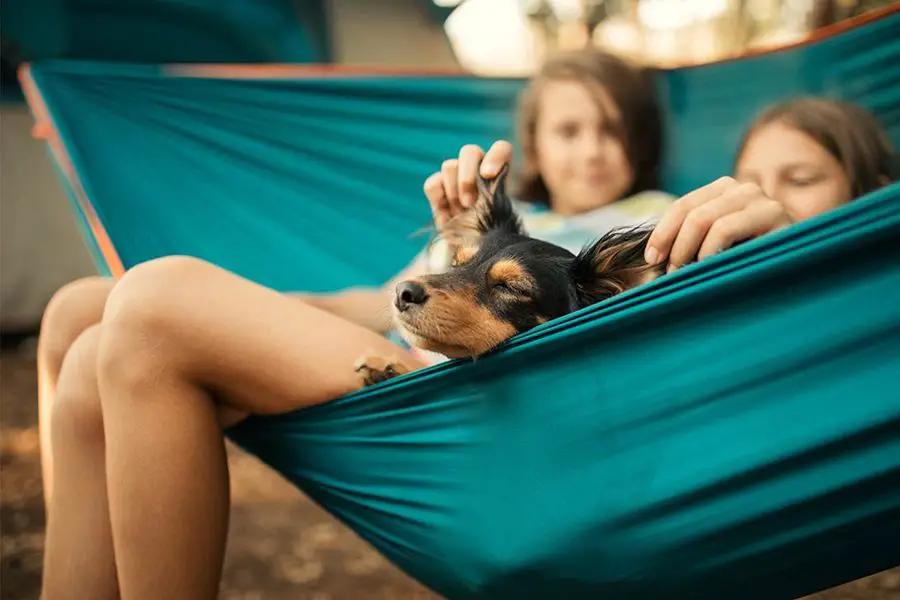SHTFPreparedness may collect a share of sales or other compensation from the links on this page.
When done correctly, hammock camping with your loving companion is the best.
We say this because many people forget to consider certain factors before taking their dog hammock camping.
But you have an advantage; you’ll have a clear understanding of what to expect when taking your dog hammock camping.
10 Tips for Hammock Camping With Your Dog
First check our infographic:

1. Do a Test Run in the Backyard
Plan ahead to see how well your dog will sleep while hammock camping. We recommend testing a hammock with your dog at home, in your backyard, or at the local park.
Some dogs will naturally get the hang of hammocking and love cuddling with you in the hammock. Perhaps others are too big or scared to share the hammock.
This isn’t an issue because many people hammock camp with their dogs, allowing them to sleep underneath the hammock (more on this later).
But if your dog can’t sleep without being next to you and can’t seem to get the hang of the hammock, it may be wise to avoid taking them on your next trip.
By figuring out how your dog prefers to hammock with you beforehand, you can better prepare for your trip, making it more enjoyable for everyone.
Don’t forget to make sure your dog fits in the hammock with you! For smaller or medium-sized dogs, you can probably get away with a single-person hammock. For larger dogs, you may want to get a double-wide hammock that’s meant to sleep two.
2. Mind Your Dog’s Aggression Level
If your dog isn’t very well-behaved, I would advise you to avoid hammock camping.
The last thing you’d want is for your dog to run off from your campsite into the woods, chasing after a squirrel. Even worse, your dog might venture into another person’s campsite.
Overly aggressive dogs will also have trouble behaving themselves whenever they see any small animals or fellow campers.
You wouldn’t want another person’s aggressive dog coming at you when hiking or camping. Be considerate and avoid taking your dog hammock camping if they have issues with aggression.
3. Groom Your Dog Beforehand
One obvious example that comes to mind is grooming dogs whose long coats may make them uncomfortable in the summer heat.
Even if you don’t go on any long hikes, spending all day outdoors in the heat could make your dog overheat. This is particularly true if your dog hasn’t yet shed their winter coat.
If you plan on sleeping with your dog in your hammock, you’ll also want to trim your dog’s nails.
Trimming your dog’s nails serves two purposes:
- It keeps your dog from tearing holes in your hammock.
- Your dog’s sharp nails won’t repeatedly stab you while you’re trying to sleep.
You can either trim your dog’s nails at home or take them to a groomer and have them trim your dog’s claws for you.
4. Mind Your Dog’s Fitness Level
Your dog’s physical fitness is one of the most important factors to consider. Give yourself an honest evaluation of your dog’s fitness based on their breed and everyday activity levels.
If your dog is of a breed that’s naturally inclined to run many miles a day, such as a German shorthaired pointer, then you’ll have less to worry about on longer hikes.
For smaller or older dogs, you may want to stick to less intensive hammock camping trips. Keep the activity to shorter hikes or carry your dog to the campsite if you’re not camping at a sanctioned campground.
While hiking, smaller or older dogs can easily tire out. Dogs in general don’t have the same endurance levels as humans, let alone smaller and older dogs.
When you’re hiking, your dog may not stop when tired, as their loyalty instinct may cause them to exhaust themselves beyond what is considered healthy just to keep up with you.
Sharp rocks and hard objects on the trail can also injure smaller or older dogs more easily.
5. Get Your Dog Up-to-Date on Vaccines
You’ll definitely want to take a few extra steps to prepare for a hammock camping trip with your dog.
Please don’t skip this step. If you miss one or two of these, you may end up regretting that you didn’t prepare more.
While it may seem harmless enough, we would recommend you make sure your dog has the latest vaccines.
There is a very long list of diseases your dog can contract, including waterborne illnesses, bacterial infections, and parasites such as mosquito heartworms.
6. Invest in Flea and Tick Protection
- Natural Flea and Tick Protection: Our dog flea and tick…
- Convenient Chewable Tablets: Our chewable tablets make flea…
- Suitable for All Breeds and Ages: Our flea and tick…
Don’t forget to give your dog flea and tick protection.
You can talk to your vet about your preferred method or simply pick up some flea and tick medicine that you apply yourself.
Either way, you’ll be doing your dog and yourself a huge favor. Ticks and fleas aren’t enjoyable for anybody, especially if you’re sleeping together.
7. Bring the Right Gear for Your Dog
A dog that prefers to sleep in the hammock with you won’t need as much gear as a dog that prefers the ground.
You should be able to get away with your normal hammock camping essentials, such as a bug net, rain cover, quilts, and sleeping pad. If you plan on hammock camping in the winter, you’ll also want to bring extra insulation.
If you found that your pooch would prefer to sleep on the ground beneath your hammock, you’ll want some extra items to make their night easier.
Here’s a list of extra gear to pack for your dog when they sleep beneath your hammock.
- Dog leash
- Sleeping pad/material
- Warm, wind-resistant blanket
- Mosquito net
- Rain tarp or cover.
- Spare a towel (clean water or mud off your dog).
This long list of extras should be as comfortable as your hammock. One way to reduce the number of items required is to give your dog their own single-person hammock.
This will eliminate the need to bring everything except a sleeping pad and blankets to keep them warm and comfortable.
8. Pack Plenty of Water
This one is obvious but absolutely critical. Your dog will need lots of water when they’re active outdoors all day.
We found there’s no hard-and-fast rule for the amount of water to pack, but it’s best to be generous. We’d recommend a liter of water per day for each large dog you plan to take camping.
This should be enough to keep them hydrated for a fun-packed day that includes a few miles worth of hiking in hot weather.
Although smaller dogs can get away with less, pack generously. Better safe than sorry.
9. Scout Out a Good Campsite
First and foremost, make sure the campsite allows dogs. If you’re staying at a sanctioned campsite, call ahead and make sure they allow dogs. Be sure to follow campsite rules regarding leashes and picking up poop.
Ideally, you’ll want a flat campsite with clean grounds free of trash and dangerous debris. We wouldn’t want to worry about my dog stepping on broken glass bottles or sleeping on sloped terrain.
While camping on a hillside is possible, it will be harder for both of you. If you’re sleeping in a hammock with your dog, sloped terrain can make getting your dog in and out of the hammock more dangerous.
It can already be awkward lifting a large dog into a hammock, and sloped terrain only adds to the difficulty. For dogs who prefer sleeping on solid ground, sloped terrain could make their situation more challenging.
They can struggle to get comfortable and feel secure. Plus, it adds an unnecessary risk of injury while sleeping. Many dogs move around while dreaming, which could cause them to go tumbling down a slope.
In short, save both of you a lot of trouble and scout out a flat campsite for a more comfortable night’s sleep.
10. Pay Close Attention to the Weather
You might be able to hammock in the toughest weather conditions, but your dog may be less willing.
Sure, they could sleep, but a rough thunderstorm with heavy rain may keep them awake. Make sure to closely monitor the weather beforehand to ensure your dog’s happiness.
If you know your dog doesn’t like thunder, and the weather forecast has a chance of thunderstorms, it may be wise to delay your trip until it clears up.
Use your best judgment here, and call it appropriately. You know your dog better than anyone else.
If you know your dog will have no trouble sleeping in a hammock during a rainstorm, then camp away.
Wrap-Up
As you can see, hammock camping with a dog isn’t too hard.
Planning ahead is 90% of the battle. Once you make it to the campsite, it’s smooth sailing, given that you’ve properly prepared.
If you know someone who would like to hammock camp with their dog, share this article with them.
They may end up finding an activity they can enjoy with their dog for the rest of their lives.
















